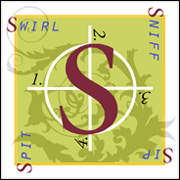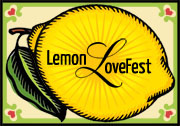|
25 Aug
2008 |
Lispida From Ispida 
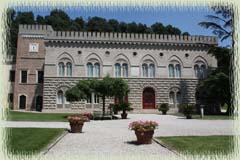 There is a little piece of heaven not far from Padova, Italy, where you will discover a castle with terraced vineyards and lush grounds so serene that one cannot imagine it was ever assaulted by invaders from afar. The original Castello di Lispida dates back to at least 1150 A.D. when Pope Eugene III decreed the Augustine monastic order as the owner of the property and church dedicated to St. Mary of Ispida. The monastery building (now the wine cellar) dates from the 1500s. The newer castle building followed in the 1800s. Around the 1830s, the Conti Corinaldi family from Livorno held the property and began producing wines that were renowned throughout Europe. It is immediately obvious that history is not in short supply here.
There is a little piece of heaven not far from Padova, Italy, where you will discover a castle with terraced vineyards and lush grounds so serene that one cannot imagine it was ever assaulted by invaders from afar. The original Castello di Lispida dates back to at least 1150 A.D. when Pope Eugene III decreed the Augustine monastic order as the owner of the property and church dedicated to St. Mary of Ispida. The monastery building (now the wine cellar) dates from the 1500s. The newer castle building followed in the 1800s. Around the 1830s, the Conti Corinaldi family from Livorno held the property and began producing wines that were renowned throughout Europe. It is immediately obvious that history is not in short supply here.
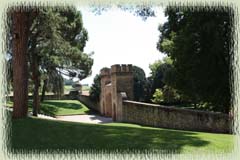 Flash forward to 1960, when an Italian gentleman was searching for a place to build the Padova golf course. On the way, he happened upon Castello di Lispida and recognized its potential. By then, the property was abandoned and in dire need of renewal. In 1985, his grandson, Dr. Alessandro Sgaravatti (then a medical student), arrived at the property and Lispida’s current renaissance began.
Flash forward to 1960, when an Italian gentleman was searching for a place to build the Padova golf course. On the way, he happened upon Castello di Lispida and recognized its potential. By then, the property was abandoned and in dire need of renewal. In 1985, his grandson, Dr. Alessandro Sgaravatti (then a medical student), arrived at the property and Lispida’s current renaissance began.
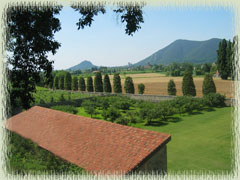 Lispida is in the vicinity of Monselice, which is a short 20 km trip southeast of Padova (or Padua to us Americans). It lies in the heart of the Euganean Hills Natural Park. I was able to spend some time strolling through their terraced vineyard, which has a wonderful view of their grounds and the surrounding countryside. The peaceful stillness of the vineyard was interrupted only by the crunch of my footsteps and the murmur of a carefree afternoon breeze—a perfect way to renew the spirit following our drive that day from Tuscany (about five hours away, not counting our stopover for lunch in Bologna).
Lispida is in the vicinity of Monselice, which is a short 20 km trip southeast of Padova (or Padua to us Americans). It lies in the heart of the Euganean Hills Natural Park. I was able to spend some time strolling through their terraced vineyard, which has a wonderful view of their grounds and the surrounding countryside. The peaceful stillness of the vineyard was interrupted only by the crunch of my footsteps and the murmur of a carefree afternoon breeze—a perfect way to renew the spirit following our drive that day from Tuscany (about five hours away, not counting our stopover for lunch in Bologna).
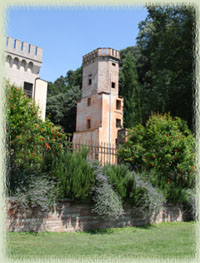 Lispida’s grounds encompass the main castle building and castle towers, the vineyards, the gardens, the indoor swimming pool and the monastery building. The monastery building is quite large and serves as a grand hall for weddings, conferences and other large parties and events. Standing at ground level, however, it is impossible to know that what fascination awaits you below.
Lispida’s grounds encompass the main castle building and castle towers, the vineyards, the gardens, the indoor swimming pool and the monastery building. The monastery building is quite large and serves as a grand hall for weddings, conferences and other large parties and events. Standing at ground level, however, it is impossible to know that what fascination awaits you below.
It turns out that the Conti Corinaldi family had constructed a maze of nine tunnels extending up to 55 meters in length below the original monastery building. The capacity of the wine cellar makes it one of the largest in the Veneto region. When we visited, the weather was extremely hot and humid, but the wine cellar, constructed of terracotta bricks, was cool and very comfortable. It is a perfect environment for winemaking.
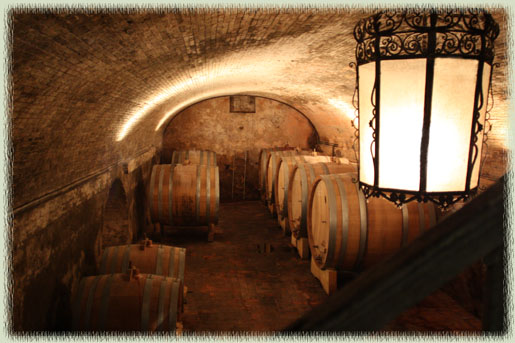
In 1991, Alessandro graduated in medicine and by 1995 his first vintage was fermenting in the cellar. Two years later, Lispida released its 1995 Terralba, originally made from Chardonnay grapes. One of the unusual items in Lispida’s wine cellar is the collection of huge (about 8 foot tall) amphoras—oversized terracotta vase-like containers—that are buried in the ground to further control temperature. Lispida began using the amphoras in 1996 to make its Amphora white (using Tocai grapes). The 2001 vintage was the first Italian wine made by using this ancient Roman winemaking method. Lispida’s other wines are made using barrel fermentation. Regrettably, we didn’t get a chance to try the Amphora white or red wines during our brief visit.
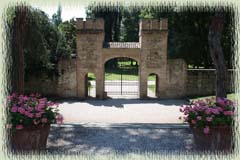 The name Lispida is a variation on Ispida, the ancient name of the area. Elisa, our Lispida hostess, explained that “terra ispida” means “land difficult to grow things”. Nevertheless, Lispida uses natural farming and winemaking methods. Their website even gives honor to Masanobu Fukuoka, the father of natural farming. Natural farming is different from organic farming, although there is some overlap between the two. Organic farming relies, among other things, on crop rotation, compost, biological pest control and mechanical cultivation and excludes the use of synthetic fertilizers, synthetic pesticides and genetically modified organisms. Though natural farming is generally “organic” in nature, it doesn’t apply the science of organics to improve yield or control pests. It is sometimes referred to as “do nothing” farming in that there is no weeding, tilling or application of any pesticides or fertilizer (even organic ones). As Lispida’s website proclaims, “The soil our vines are rooted in undergoes no sort of treatment whatsoever, we avoid chemical weed-killers, chemical or organic fertilzers.”
The name Lispida is a variation on Ispida, the ancient name of the area. Elisa, our Lispida hostess, explained that “terra ispida” means “land difficult to grow things”. Nevertheless, Lispida uses natural farming and winemaking methods. Their website even gives honor to Masanobu Fukuoka, the father of natural farming. Natural farming is different from organic farming, although there is some overlap between the two. Organic farming relies, among other things, on crop rotation, compost, biological pest control and mechanical cultivation and excludes the use of synthetic fertilizers, synthetic pesticides and genetically modified organisms. Though natural farming is generally “organic” in nature, it doesn’t apply the science of organics to improve yield or control pests. It is sometimes referred to as “do nothing” farming in that there is no weeding, tilling or application of any pesticides or fertilizer (even organic ones). As Lispida’s website proclaims, “The soil our vines are rooted in undergoes no sort of treatment whatsoever, we avoid chemical weed-killers, chemical or organic fertilzers.”
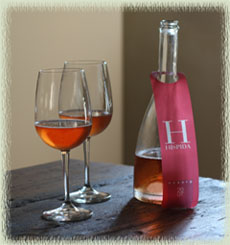 All well and good, but does the wine taste good? In short, yes. While we didn’t have the opportunity to taste all of their wines, the ones we did try were very nice. The 2007 sparkling wines—labelled “Hispida” (another variation on the name) Vino Spumante Brut Bianco (based on Tocai grapes) and Hispida Vino Spumante Brut Rosato (based on Sangiovese grapes)—were very beautiful in color. Elisa had thoughtfully placed a bottle of the Rosato in our apartment’s refrigerator prior to our arrival and it was the perfect refresher on that hot summer afternoon. (We enjoyed the Spumante Bianco a few days later.)
All well and good, but does the wine taste good? In short, yes. While we didn’t have the opportunity to taste all of their wines, the ones we did try were very nice. The 2007 sparkling wines—labelled “Hispida” (another variation on the name) Vino Spumante Brut Bianco (based on Tocai grapes) and Hispida Vino Spumante Brut Rosato (based on Sangiovese grapes)—were very beautiful in color. Elisa had thoughtfully placed a bottle of the Rosato in our apartment’s refrigerator prior to our arrival and it was the perfect refresher on that hot summer afternoon. (We enjoyed the Spumante Bianco a few days later.)
During our tour of the wine cellar, we also learned about Lispida’s Terralba (80% Tocai and 20% Ribolla Gialla), which is fermented in the cellar with only natural yeast and the cellar’s natural temperature. Because the released vintages of Terralba are out of stock, we tasted the upcoming 2005 vintage directly from the barrel. It was already very nice and should improve by release time around November 2008. Our favorite of the tasting was the 2002 Terraforte (50% each, Sangiovese and Merlot), which macerates in wood vats for at least two months and is then refined for 4 years in a large oak vats. Further into our travels, we also enjoyed their 2002 Montelispida (100% Merlot), which is made through a process very much like that of the Terraforte.
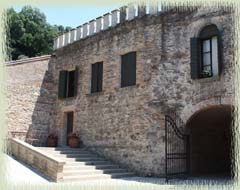 For dinner, Elisa referred us to Da Mario Trattoria In the nearby town of Montecelli, just one km from the castle. The sign on their establishment includes the phrase “Cucina Casalinga”, which loosely translated means “homemade cooking”. Needless to say, the atmosphere and food were wonderful, especially dining al fresco on the garden patio in candlelight. As for lodging, Lispida now has six well-appointed suites and a large, separate apartment where we stayed for a night on our trip between homes at Spannocchia in
For dinner, Elisa referred us to Da Mario Trattoria In the nearby town of Montecelli, just one km from the castle. The sign on their establishment includes the phrase “Cucina Casalinga”, which loosely translated means “homemade cooking”. Needless to say, the atmosphere and food were wonderful, especially dining al fresco on the garden patio in candlelight. As for lodging, Lispida now has six well-appointed suites and a large, separate apartment where we stayed for a night on our trip between homes at Spannocchia in 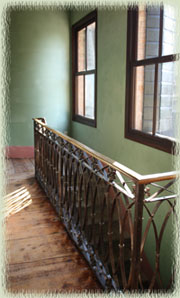 Tuscany and Bosco Chiesavuova in the Lessinia hills above Verona. Our two-floor apartment (named Gli Ulivi for the olive trees) had three bedrooms, four bathrooms (3 with Jacuzzi) and a huge open kitchen and family room with a high-end “rustic” design. They have achieved an Italian wine-country look and feel, but included every modern convenience and comfort you could desire. The skylights in the upstairs bedrooms can be uncovered by remote control to reveal the moon and the stars, while you can conveniently cover them in the daytime to control the interior lighting. Lispida has a picturesque indoor pool, situated just below the terraced vineyards and looking out over their spacious gardens. The pool is housed in a historical greenhouse building that dates to 1870. The pictures of the castle and the pool area on Lispida’s website are worth viewing. The vineyards, gardens and accommodations were more than enough to attract us, but we were really there to sample their wines and see their extensive wine cellar.
Tuscany and Bosco Chiesavuova in the Lessinia hills above Verona. Our two-floor apartment (named Gli Ulivi for the olive trees) had three bedrooms, four bathrooms (3 with Jacuzzi) and a huge open kitchen and family room with a high-end “rustic” design. They have achieved an Italian wine-country look and feel, but included every modern convenience and comfort you could desire. The skylights in the upstairs bedrooms can be uncovered by remote control to reveal the moon and the stars, while you can conveniently cover them in the daytime to control the interior lighting. Lispida has a picturesque indoor pool, situated just below the terraced vineyards and looking out over their spacious gardens. The pool is housed in a historical greenhouse building that dates to 1870. The pictures of the castle and the pool area on Lispida’s website are worth viewing. The vineyards, gardens and accommodations were more than enough to attract us, but we were really there to sample their wines and see their extensive wine cellar.
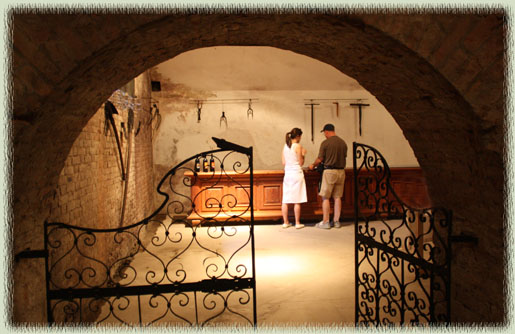
In addition to their wines, Lispida’s wine cellar is an attraction by itself. From the maze of tunnels to the amphoras, there are many interesting historical details and artifacts to behold. For example, 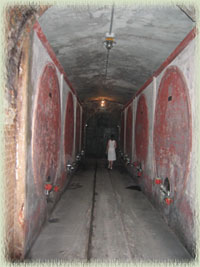 in one tunnel, there are huge vats encased in cement on both walls, which were used for wine production until the mid-1900s. Lispida is planning to take its historical treasures to the next level. They plan to open a wine museum and wine bar in the cellar this winter. This makes perfect sense, because Lispida has amassed an extensive collection of wine tools, devices and artifacts used in the grape growing and winemaking processes over the centuries and it is all housed in an interesting, historical wine cellar. Elisa showed us a preview of just a part of their collection, which is impressive. For people who don’t have the privilege of staying overnight at Lispida, a visit to the wine cellar, museum and wine bar will enable more people to experience some of what we enjoyed so much during our brief stay.
in one tunnel, there are huge vats encased in cement on both walls, which were used for wine production until the mid-1900s. Lispida is planning to take its historical treasures to the next level. They plan to open a wine museum and wine bar in the cellar this winter. This makes perfect sense, because Lispida has amassed an extensive collection of wine tools, devices and artifacts used in the grape growing and winemaking processes over the centuries and it is all housed in an interesting, historical wine cellar. Elisa showed us a preview of just a part of their collection, which is impressive. For people who don’t have the privilege of staying overnight at Lispida, a visit to the wine cellar, museum and wine bar will enable more people to experience some of what we enjoyed so much during our brief stay.
Comments (10)
August 25, 2008 at 10:53 am
Alessandro Sgaravatti said:
Dear Rich,
Your article is not only accurate and without any mistake but, more than this, is warm and full of passion. I really enjoyed to “discover” Lispida through the eyes of a “modern traveller” and felt the gratification of a long term effort that finally gives the expected results. I hope to see you in a near future and thank you so much for your beautiful review!
Arrivederci.

Rich said:
The review was well-deserved. You have done a wonderful thing at Lispida.
Ciao!

Alfonso said:
Perfect timing, I was just wondering about that winery….nice pix too..Grazie

Rich said:
Alfonso,
Thanks for your comment. As you know, I am a regular reader of your blog, On the Wine Trail in Italy. Your blog writing and pictures are unique and fantastic. If you need any further information about Lispida, just let me know or write directly to Alessandro through Lispida’s website. He is very friendly and responsive.

Jon said:
Looks like you found a great place for you and the family (you did have the kids with you, right?). How did they like Lispida?
I’m already planning next summer’s vacation and need to find a good place for a family of 4 (kids are 10 and 12 yrs old).

Rich said:
Jon,
The 4 kids were with us on our visit to Lispida and they loved it. They had fun with the resident dogs, loved the beautiful pool and wandered the grounds and gardens. It is a very kid-friendly place. Anytime the kids can live at a castle, they’re going to love it. We were en route between two homes, so we were only there one night. I wish we could have stayed there longer!

Esping said:
Hi, I was so happy to find your blog. Very interesting. I brought home some bottles from Lispida this summer and so far I have tried Terralba. Still have to try the Amphora. I drank the Terralba with some other great natural wines that I very much recommend, 2006 Trinchero Sogno di Bacco Malvasia, 2004 Zidarich Malvasia and 2003 Simcic Rebula

Rich said:
Esping,
Thanks for the comment and the leads on other natural wines. I am finding more and more natural wines that are so fresh and wonderful. As I said in the article about Lispida, we didn’t get a chance to sample the Amphora. If you remember, please return and post a comment about the Amphora after you open the bottle! Keep blogging!

esping said:
Rich, I finally got round to opening the Amphora bianco and it was a defect bottle. I thought that it might have something to do with the transportation from Italy to here had been under less than perfect conditions and asked mr Sgaravatti about it. He offered a new bottle and also to exchange all bottles that I had purchased of the 2005 vintage. That is what I call customer friendly. Anyway, I’ll visit the winery during x-mas holiday and I’m really looking forward to it.

Rich said:
Esping, it’s nice to hear how consumer-friendly Dr. Sgaravatti is. I’m not surprised as he was gracious to us and is rightly proud of his wines. Have a great holiday and let us know how you enjoy your visit there. Regards, Rich










